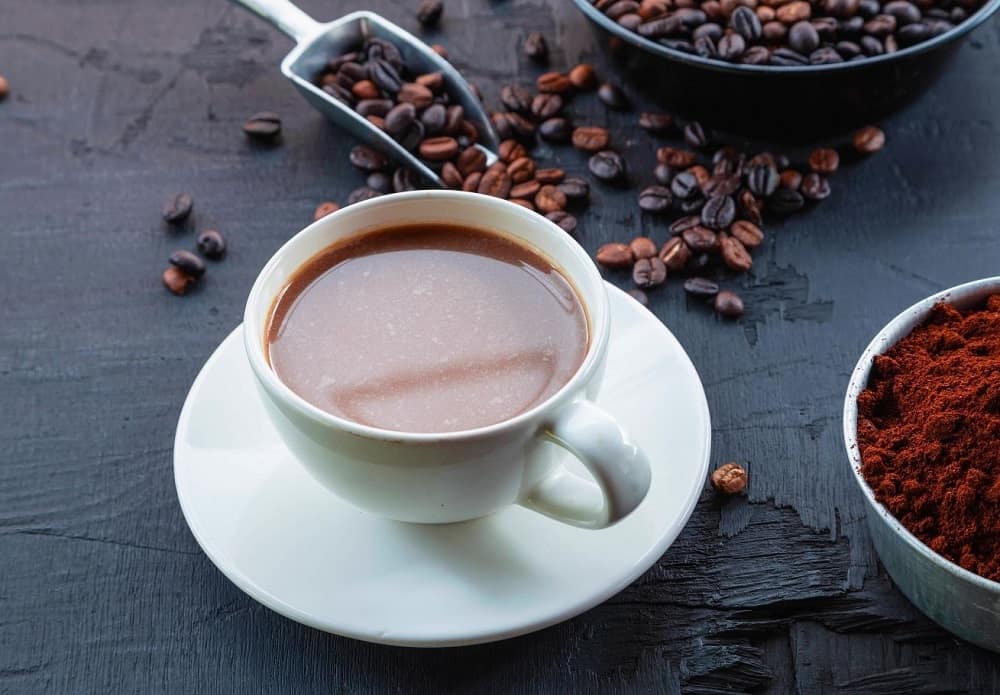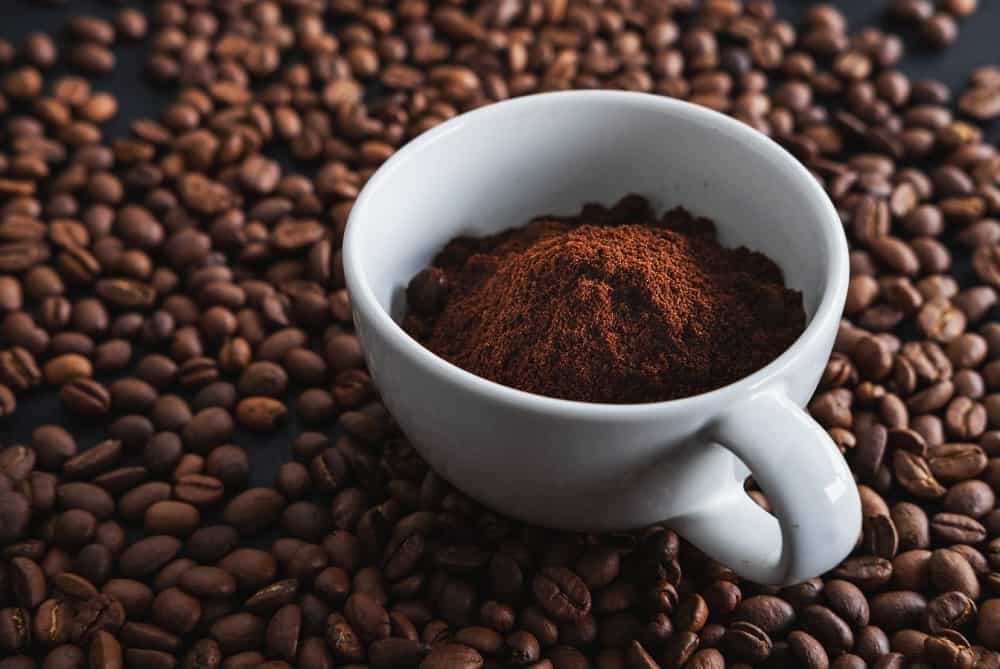Last updated on May 30th, 2023 by Jules Winnfield

There’s almost nothing better than having a steaming cup of coffee first thing in the morning. It’s the perfect way to wake yourself up and get ready for the long day ahead.
A lot of people love going to coffee shops for their drink of choice, but this can get very expensive over time. We’re talking to you Starbucks!
So let’s say you want to learn how to make perfect coffee from home. A common question that comes up is how many coffee scoops per cup do you need?
To add to the complexity, coffee measurements can be a bit confusing sometimes, especially because there are so many different ways you can do it depending on the brew style, how strong you’re making it, the size of your cup, or how many cups you are making.
So to help you out, we put together this quick easy guide on how to measure out the perfect cup of coffee regardless of the measurements you’re using or how big your cup is.
If how many grams of coffee you need and coffee to water ratios confuse you, not to worry! Read on to learn how to make the very best flavorful cup of coffee quickly and easily for a stress free early morning!
How Many Coffee Scoops per Cup?
For a delicious cup of coffee, the first question is understanding the relationship between how much coffee and water to use.
To start with the basics, you need to know how many tablespoons are equal to 1 scoop.
On average 1 coffee scoop is equal to 2 tablespoons. If you’re using this method then you’ll want to use 1 coffee scoop for every 8 oz. of water. The average coffee cup can hold 8-12 oz depending on its size, so you may want to use 1 to 1 1/2 scoops or 2 to 3 tablespoons for your ground coffee.
How you like your coffee is often a very personal thing though, so it’s best to experiment with these measurements. If you find it’s too strong then there’s no harm in having less coffee, just do what’s right for you.
The Golden Ratio

If you want to get technical with it you could use the Golden Ratio method. Developed by the Speciality Coffee Association of America (SCAA), they have found what they believe to be the perfect ratio of coffee to water.
In general, the SCAA recommends the ideal coffee to water ratio be between 1:15 – 1:18 (coffee: water). So for a 150 ml cup (around 5 oz), you would take this number and divide it by 18, making 8.3 grams of coffee per cup.
If you’re grinding your own coffee beans and you don’t have a scale, you may be interested to know that 8.3 grams of ground coffee is around 70 coffee beans.
Looking for one? Check this best coffee scales list to to see which is best for you.
If you can’t be bothered to measure out the grams of your morning coffee (and honestly who can) then just remember that 8.3 grams of coffee is equal to 1.6 tablespoons, so just over one and a half. It’s not precise measurement, but it’s a small price to pay if you’re short on time.
Once again, keep in mind these measurements of coffee per cup are not set in stone. They can vary depending on the brew style, resources available (maybe you’re making coffee without a coffee maker or you have an automated pour over brewer), coffee beans, and your own personal preference.
Also, there are lots of other variables to consider as well if you want the Golden Cup: time, temperature, and flow rate being the biggest.
How to Measure Tablespoons of Coffee if You’re Making More Than One Cup?
Brewing coffee for yourself is easy, but if you’re using a coffee pot to make drinks for a lot of people, things may start to get a bit confusing.
To keep it simple, just know that on average the number of tablespoons of coffee grounds you add to the water roughly doubles with every cup of water you’ll be making.
So if one cup of coffee = 1.6 tablespoons, then 2 cups of coffee = 3.2 tablespoons.
Things do start to get more confusing the higher up the scale you go as not all the measurements are made equal. So if you’re brewing coffee for 5 people or a full 12 cup pot, it’s best to look up charts online to see exactly how many tablespoons of ground coffee you’ll need.
What About Other Measurements?
Scoops and tablespoons are not the only units of measurement that people use though. Here are some other ways of measuring coffee so you have just enough for one cup.
- Teaspoons = 6
- Cups = 1/8ths of a cup (easier if you have a measuring cup with readings on the side)
- Grams = 10.6 (though the golden ratio recommends 8.3; if you want a stronger cup than this is a better choice)

Can I Use These Same Measurements in a Coffee Pot?
Yes you sure can!
Lets say you’re at work or you’re making coffee for a large gathering, using the doubling method (1 cup =1.6 tablespoons, 2 cups = 3.2 tablespoons, etc.) you can easily work out the amount you have to put in to fill the pot with the right amount.
But if you’re using proper measuring tools for your coffee, the method you use will be a bit different. This is because of the differences between a standard cup of liquid, which is around 8oz, and a cup of coffee, which is around 6oz.
On top of this, the measurements on the outside of the coffee pot may not accurately represent the cup measurements either.
This is a bit confusing, so let’s look at an example.
- Your coffee pot reads 6 cups. Technically 6 cups = 48 oz. (1 cup = 8 oz)
- But 6 cups on your coffee pot may actually mean only 36 oz of brewed coffee. In this case 1 cup = 6 oz, which would result in just over 4 servings of coffee.
Final Verdict: What’s the Best Way to Measure Coffee?
To be honest, there is no right or wrong way to measure out your coffee. Some people use tablespoons or teaspoons, while others just pour the coffee beans into their cup and hope for the best.
It probably comes down to what resources you have available, which brewing methods you prefer, how much time you have to invest in the brewing process, and how much you care about a perfectly measured delicious cup of coffee.
Coffee is a great drink to experiment with and everyone likes theirs done a little differently, so if you find that one of the methods isn’t working for you, then try out a different one to see what works best.
If you’re thinking about which coffee brewing methods to start trying, take a look at pour over coffee brewing if you really want to hone your barista skills, french press if you want robust flavor, espresso for the rich crema, or a nice drip coffee maker if you want to keep it simple.
Coffee Has Never Read This Good!
Sign up for a FREE newsletter to the best home brewing tips and guides
Thank you for subscribing to The Cup Coffee House Crew! There's a surprise in your Inbox 🙂
Something went wrong.
- About the Author
- Latest Posts

“Jules” is a pharmacist by day and investor, writer, and health nut by night. When he’s not sipping on some coffee laced with MCT oil during an 18 hour fast, he is writing about how to get your coffee grind on or playing Monopoly with his 2 boys and wife. Ahh…life is good!
